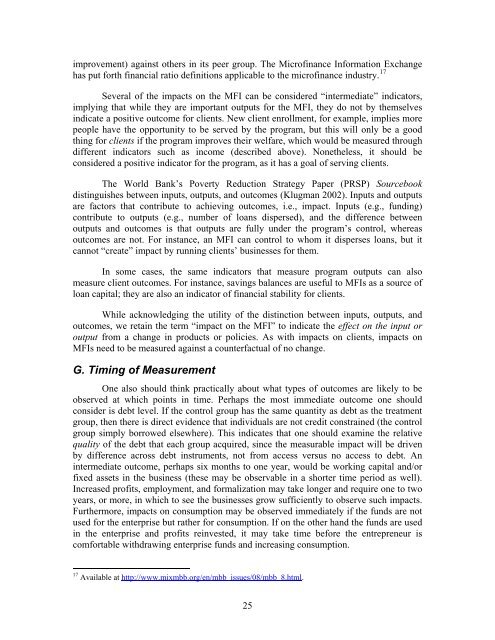Impact Evaluation for Microfinance: Review of Methodological Issues
Impact Evaluation for Microfinance: Review of Methodological Issues
Impact Evaluation for Microfinance: Review of Methodological Issues
Create successful ePaper yourself
Turn your PDF publications into a flip-book with our unique Google optimized e-Paper software.
improvement) against others in its peer group. The <strong>Micr<strong>of</strong>inance</strong> In<strong>for</strong>mation Exchange<br />
has put <strong>for</strong>th financial ratio definitions applicable to the micr<strong>of</strong>inance industry. 17<br />
Several <strong>of</strong> the impacts on the MFI can be considered “intermediate” indicators,<br />
implying that while they are important outputs <strong>for</strong> the MFI, they do not by themselves<br />
indicate a positive outcome <strong>for</strong> clients. New client enrollment, <strong>for</strong> example, implies more<br />
people have the opportunity to be served by the program, but this will only be a good<br />
thing <strong>for</strong> clients if the program improves their welfare, which would be measured through<br />
different indicators such as income (described above). Nonetheless, it should be<br />
considered a positive indicator <strong>for</strong> the program, as it has a goal <strong>of</strong> serving clients.<br />
The World Bank’s Poverty Reduction Strategy Paper (PRSP) Sourcebook<br />
distinguishes between inputs, outputs, and outcomes (Klugman 2002). Inputs and outputs<br />
are factors that contribute to achieving outcomes, i.e., impact. Inputs (e.g., funding)<br />
contribute to outputs (e.g., number <strong>of</strong> loans dispersed), and the difference between<br />
outputs and outcomes is that outputs are fully under the program’s control, whereas<br />
outcomes are not. For instance, an MFI can control to whom it disperses loans, but it<br />
cannot “create” impact by running clients’ businesses <strong>for</strong> them.<br />
In some cases, the same indicators that measure program outputs can also<br />
measure client outcomes. For instance, savings balances are useful to MFIs as a source <strong>of</strong><br />
loan capital; they are also an indicator <strong>of</strong> financial stability <strong>for</strong> clients.<br />
While acknowledging the utility <strong>of</strong> the distinction between inputs, outputs, and<br />
outcomes, we retain the term “impact on the MFI” to indicate the effect on the input or<br />
output from a change in products or policies. As with impacts on clients, impacts on<br />
MFIs need to be measured against a counterfactual <strong>of</strong> no change.<br />
G. Timing <strong>of</strong> Measurement<br />
One also should think practically about what types <strong>of</strong> outcomes are likely to be<br />
observed at which points in time. Perhaps the most immediate outcome one should<br />
consider is debt level. If the control group has the same quantity as debt as the treatment<br />
group, then there is direct evidence that individuals are not credit constrained (the control<br />
group simply borrowed elsewhere). This indicates that one should examine the relative<br />
quality <strong>of</strong> the debt that each group acquired, since the measurable impact will be driven<br />
by difference across debt instruments, not from access versus no access to debt. An<br />
intermediate outcome, perhaps six months to one year, would be working capital and/or<br />
fixed assets in the business (these may be observable in a shorter time period as well).<br />
Increased pr<strong>of</strong>its, employment, and <strong>for</strong>malization may take longer and require one to two<br />
years, or more, in which to see the businesses grow sufficiently to observe such impacts.<br />
Furthermore, impacts on consumption may be observed immediately if the funds are not<br />
used <strong>for</strong> the enterprise but rather <strong>for</strong> consumption. If on the other hand the funds are used<br />
in the enterprise and pr<strong>of</strong>its reinvested, it may take time be<strong>for</strong>e the entrepreneur is<br />
com<strong>for</strong>table withdrawing enterprise funds and increasing consumption.<br />
17 Available at http://www.mixmbb.org/en/mbb_issues/08/mbb_8.html.<br />
25






